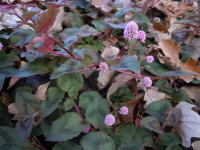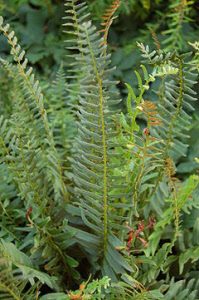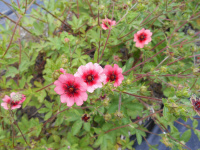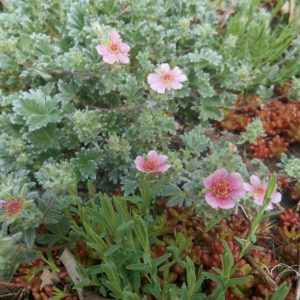Perennials & Biennials
Showing 353–360 of 485 results
-
Polygonatum multiflorum Solomon’s seal Z 4-10
Dangling dainty white bells in June followed by black fruit on the arching stem. The leaves “make a fine mass of elegant foliage,” Sanders, 1913.
Dangling dainty white bells in June followed by black fruit on the arching stem. The leaves “make a fine mass of elegant foliage,” Sanders, 1913.
Size: 5' x 10"
Care: shade in fertile, humusy, well-drained soil. Good dry shade plant
Native: Europe and AsiaGreek physician Dioscorides named Polygonatum in the 1st century, which means “many jointed” referring to scars on the rhizome. Medieval herbalists opined that Biblical figure Solomon put scars on the rhizome to demonstrate the plant’s curative powers. P. multiflorum cultivated in English gardens by 1450. In 1596 English herbalist Gerard endorsed its use to repair broken bones – mix the pulverized root and drink it with ale to “gleweth together the bones in very short space.” He also claimed fresh stamped root of Polygonatum would cure cuts and bruises for “women’s willfulness in stumbling on their hasty husband’s fists.” According to Culpepper, Italian wives “much used” this remedy. American gardens since 1700’s.
-
Polygonum capitatum Pinkhead knotweed, in China tou hua liao. Z 7-11 Reseeding annual in colder areas. Reseeds generously but not until it warms in late spring or early summer.
Petite, oval-shaped spikes of pink flower heads June through October, with ornamental, chevron-like pattern on the leaves. Wonderful groundcover, good for rock gardens and containers and between stepping stones and anyplace you want to put a plant.
Petite, oval-shaped spikes of pink flower heads June through October, with ornamental, chevron-like pattern on the leaves. Wonderful groundcover, good for rock gardens and containers and between stepping stones and anyplace you want to put a plant.
Size: 5” x 12”
Care: sun to part shade in moist to moist well-drained soil
Native: China, Thailand, Vietnam, Afghanistan, Malaysia & NepalCollected for western gardens by 1825. Used medicinally in Asia. Polygonum from Greek polys meaning “many” and gonu for “knee” or “joint” for the thickened joints on the stem. Capitatum means “dense head.”
-
Polystichum acrostichoides Christmas fern Z 3-10
Leathery, lance-shaped evergreen fronds stay fresh and green through winter.
OUT OF STOCK
Leathery, lance-shaped evergreen fronds stay fresh and green through winter.
Size: 18" x 18"
Care: part shade to full shade in most any soil, nearly indestructable
Native: Every state east of the Rockies, Wisconsin native
Awards: Kentucky's Theodore Klein Plant AwardEvergreen fronds last all winter. Called “Christmas” because in the past florists used the evergreen fronds in holiday arrangements. Collected by Michaux before 1800. Collected by French botanist and plant hunter André Michaux (1746-1802) while searching east of the Mississippi River before 1800.
**LISTED AS OUT OF STOCK BECAUSE WE DO NOT SHIP THIS ITEM. IT IS AVAILABLE FOR PURCHASE AT OUR RETAIL LOCATION.
-
Polystichum tsus-simense Korean Rock Fern Z 5-9
Compact, glossy, evergreen, narrow, arrow-shaped fronds with dark veins and black stems growing in a rosette.
Compact, glossy, evergreen, narrow, arrow-shaped fronds with dark veins and black stems growing in a rosette.
Size: 12-20” x 12-16”
Care: Shade to part shade in moist well-drained soil
Native: Korea
Wildlife Value: deer resistant
Awards: Royal Horticulture Society Award of Garden Merit. Great Plant Pick Elizabeth Carey Miller Botanic Garden1st collected “on the Island of Tsus Sima, in the Straits of Corea” by Charles Wilford (1836-18930 in 1859. Species Filicum, Vol. 4, p. 16 (1862) William J. Hooker. In 1854 Charles Wilford started as an assistant in the herbarium at the Royal Botanic Gardens, Kew. Sent to Asia in 1857 he collected plants in Hong Kong, moving to Taiwan the following year and to Korea and Japan in 1859.
-
Potentilla atrosanguinea Himalayan cinquefoil Z 5-8
Open pink cups in June-July
Open pink cups in June-July
Size: 18-24" x 24"
Care: Sun well-drained soil
Native: HimalayasPotentilla is Latin meaning powerful referring to medicinal properties. Potentillas used by dentists in the 16th century to reduce pain according to Gerard, English herbalist. Per Culpepper, 17th century English herbalist potentilla is to be used if Jupiter is ascending and the moon is “applying to him.” Atrosanguinea 1st collected in its native Nepal in 1822.
-
Potentilla nepalensis Nepal cinquefoil Z 5-9
Five-petal, open pink saucers with raspberry centers, blossom in small clusters atop leafless stems, above the clump of ground-hugging foliage. blooming in summer. “A fine species,” Liberty Hyde Bailey 1933.
Five-petal, open pink saucers with raspberry centers, blossom in small clusters atop leafless stems, above the clump of ground-hugging foliage. blooming in summer. “A fine species,” Liberty Hyde Bailey 1933.
Size: 1-2' x 12-18"
Care: sun in moist well-drained soil to well-drained soil
Native: Himalayan mountains1st described in 1822 in Exotic Flora, Vol. 2 p. 88, William Jackson Hooker. It flowered at the botanic garden in Edinburgh in 1823.
-
Potentilla porphyrantha Z 3-8
Bun of gray-green foliage sets off 7-petal pink blooms, medium pink in the center fading to light pink on the ends, surrounding a boss of stamens. Blooms in spring. One of our favorites.
Bun of gray-green foliage sets off 7-petal pink blooms, medium pink in the center fading to light pink on the ends, surrounding a boss of stamens. Blooms in spring. One of our favorites.
Size: 6” x 15”
Care: sun in moist well-drained to well-drained soil
Native: Caucasus Mountains in Armenia1st described for botany in 1940. Seems to be controversy among taxonomists about the plant’s name. Regardless, both the foliage and flowers make a beautiful little plant.
-
Potentilla rupestris syn. Drymocallis rupestris Rock cinquefoil, Siberian tea Z 5-8
White, single rose-like saucer flowers with prominent yellow stamens flowering atop leafless stems. Blooms in early summer.
White, single rose-like saucer flowers with prominent yellow stamens flowering atop leafless stems. Blooms in early summer.
Size: 10-20" x 12"
Care: sun to part shade in well-drained to moist well-drained soil
Native: Europe, Asia & mountains of western No. AmericaPotentilla is Latin meaning “powerful” referring to medicinal properties. Rupestris means “rock loving.” This species 1st identified in literature in 1650. Russians used the leaves to brew tea.







